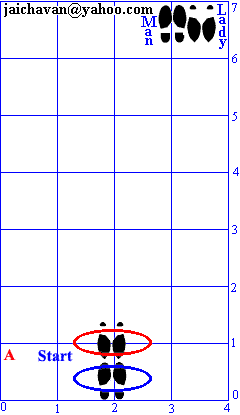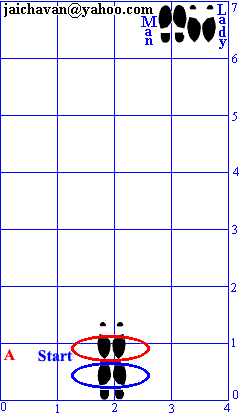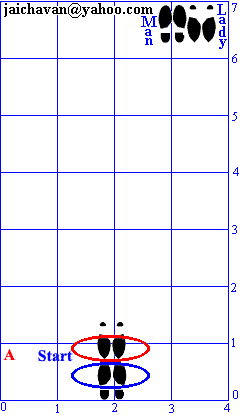
Email : [email protected] Or General Mailer
 |
Jai Chavan's
"Dance-Sport" Email : [email protected] Or General Mailer |
| Back || Master Pg. || Overview || Contents || Alphabetical Index || Home || Next |
Foxtrot: Basic Sequence: Turn Details: Part 6
| The first basic sequence. |
Please Note: This is a sequel to Foxtrot: Basic Sequence: Part 3
In Closed Hold
(Slow) In Close Hold (Medium)  In Close Hold (Little Faster)  |
Note:
The alphabetical serial order in brown is for the
movements, serial numbers in red are the steps. A Start Position. Man stands on the Right foot and Lady on the Right foot. Body weight for both the partners is on the flat foot, but more towards the ball of the foot and the knees are kept relaxed. Exert a slight Push-Pressure against each other, which is just enough to balance a 100-page notebook between the partners. Maintain such general pressure through out the dance. A point to remember here is that the one moving back resists and the one moving forward 'bulldozes'. B Man moves forward increasing the pressure, the feet remain in place, knees are relaxed. Lady reacts with controlled movement backward to maintain the pressure mentioned above. This results in the shift of her body weight on to her heel. Simultaneous Man moves on to the ball of his Right foot. Now the Lady begins to swing the Right foot back. C Lady’s body weight shifts beyond the Lady’s heel. At this stage the relaxed knees begin to straighten to push ones self into movement for the first step. At this stage, Man’s Left foot leaves the floor. In addition, at this stage the shoulders turn a little for balance. D The bodies in motion in the direction of the LOD or the Line of Dance. Man sensing the reduced pressure pushes with the Right knee straightening to flow with the Lady. E 1 Man's Left heel and Lady's Right toes lands on the ground, Man's Heel and Lady's Toes, Bodies almost in the centre of the stride. Note: The one moving back must always step on the floor slightly later than the partner must. F The body keeps moving, the Man's Right foot moves towards the Left foot and the Lady's Left foot moves towards the Right foot, and the weight is on the flat foot for both. Flex the knees are gradually to soften the landing and to accelerate the flow. G Feet are almost together and body weight shifts on Lady's Heel and Man's Ball. H In addition to the forward movement a slight tilt towards the centre (in this case the left for Man and Right for the Lady) is given by the Man. This push pushes both the partners’ upper body backward. Since the Lady is already moving back her body weight shifts further behind the heel, and for the Man a stopping action is felt for and instant. At this stage, both the partners maintain a Pull-force or else both will tend to fall backwards. Immediately after this, a strong rise begins. I The turn on Lady's heel and Man's ball begins. The weight shifts slightly more behind the Lady's Heel and on Man's toes. A slight tilt is maintained on the Man's left and the lady’s right side to control the movement in the direction of the flow, in this case it is from down to the top. This is necessary or else; the moving foot will drop to the floor too soon. The Body must keep moving in the line of the LOD. J Keep the tilt to the Left of man and the body weight behind the Lady's heel steady. The Knees are kept relaxed through out the dance although a rising gradually. K Body keeps shifting along the LOD L 2 Place the other foot on the floor, lightly taking care of each other's respective positions. M Body weight is taken on the Ball and Heel the tilt is maintained and body shifts in line with the LOD, Also a slight pull-force by the man is felt for straightening up. This results in the checking of the flow in the direction of LOD for the man, so there is a momentary pause. For the lady the Pull-force gives her the assistance to straighten up and ‘bulldoze’ against the man to move forward. N Body moves in line of LOD. O The foot leaves the floor. P The turn starts on the Ball and Heel, weight is still behind the heel. Q Continue the turn and movement. R Full turn of 180 degrees is completed. In addition, body weight shifts to the flat foot. S Body keeps moving to Lady's heel, and Man's ball. T The breaking in the turning movement leads to this turn. Both the feet are together. U The body moves further back, and the moving foot moves forward. V 3 Step on the floor with the Left foot for Man and the Right foot for the Lady. W Weight keeps moving back, to heel of Lady's foot. X the weight shifts further than the heel (Lady) and ball (Man), and the other foot leaves the floor and moves for the next step. Y The other foot lands and Finish. |
Note:
1. Even if you do not hone your skills with such
turns given here, you can nevertheless progress. However, it is
important to understand this. Which then would remain at the back
of the mind and it would act subconsciously every time when
practising.
2. Also the turn here is Reverse Turn or the turn to the Left, is
a general one, to understand the principle of turning. This
principle is generally the same irrespective of the type of dance
or the type of figure in any dance that involves turning.
3. The Natural Turn or the turn to the Right is similar to this
one. The only difference being, the one moving forward starts
with the Right foot and the partner starts with the Left foot
backwards, and the turn is to the Right.
4. One should know the turns moving forward and backward with
either foot.
| Back || Master Pg. || Overview || Contents || Alphabetical Index || Home || Next |